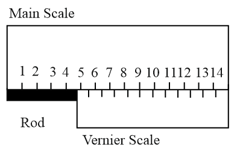Length, Mass and Time Measurement
Length, Mass and Time Measurement: Overview
This topic covers concepts such as Measurement of Masses, Measurement of Length, Direct Method and Instruments, Measurement, Vernier Callipers, Screw Gauge, One Fermi, One Angstrom, One Micron, and One Electron Volt.
Important Questions on Length, Mass and Time Measurement
In a screw gauge, the zero of main scale coincides with fifth division of circular scale in figure (i). The circular divisions of screw gauge are It moves on main scale in one rotation. The diameter of the ball in figure (ii) is:

If division of main scale coincides with divisions of vernier scale. Given one main scale division is equal to units. Find the least count of the vernier.
Consider the Vernier caliper as shown, the instrument has no zero error. The length of the rod (in ) shown is , if . Use . Write the value of .

The distance advanced by screw of a screw gauge is in four rotation. Its cap is divided into division. There is no zero error. If the screw reads divisions on the main scale and divisions on the cap, then the diameter of the wire is (in )-
What is electron volt used for?
What's the difference between electron volt and volt?
What is the difference between microns and micrometers?
The value of one angstrom is equal to _____ meter.
The value of one angstrom is equal to .
What is the value of one Armstrong?
How long is a Fermi?
One Angstrom is equal to:
What is the value of 1 Fermi?
In Fermi-Dirac Statistics, one energy state can be occupied by more than one particle.
The barn is used to measure _____.
One barn is equal to how many square meters?
Define one Barn?
One Barn is equal to how many square meters?
Least count is the smallest length that can be measured with an instrument.
What do you understand by the term least count of an instrument?
